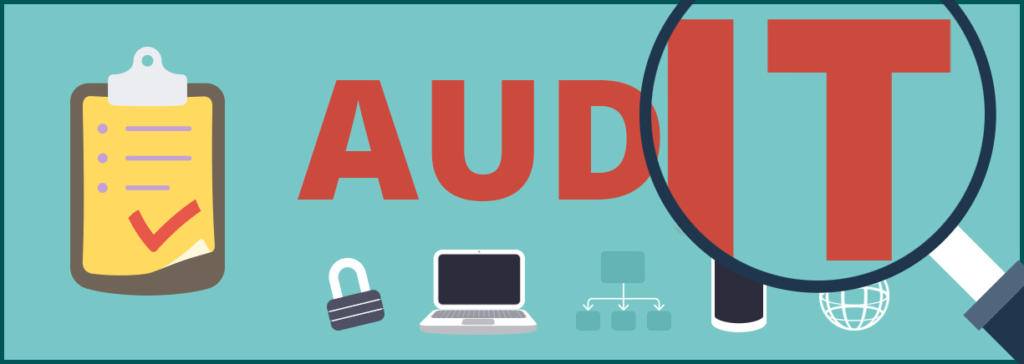In this article we will be diving deep about this interesting topic IT Audit.

Now, let us see what it means !
Introduction
Many businesses, regardless of their industry, are increasingly investing in technology.
The impact that technology can have on a business is becoming clearer every day, whether it’s in terms of money, time, or personnel.
Understanding information technology audits, also known as IT audits, which aim to guarantee your data and network are safe from attack, is one of the ways you can better invest in your organization. After all, it can be the difference between a thriving business and one that fails due to a data security breach.
Defining an IT Audit
An audit is a study of an existing system, report, or institution in general. An IT audit is a thorough examination of a company’s IT systems, management, applications, operations, data management, and other associated procedures.
An IT audit assesses if IT controls and protects corporate assets, as well as guaranteeing data integrity and aligning a company’s overall goals.
While each audit is unique, an IT audit normally follows a four-step process: preparation, fieldwork, reporting, and follow-up.
Now, let us see the types of audits !
Types Of Audits
There are five different types of IT audits, each of which can be divided into two categories: general control reviews and application control reviews. Application control is concerned with transactions and data connected to a specific computer-based application, whereas general control is concerned with all aspects of an organization.
The 5 types of audits are as follows :
– Systems and Apps : Verifying that systems and applications are secure, as well as dependable, valid, and efficient, at all levels of operation.
– Verifying that all processes are working properly and that they are under normal or disruptive circumstances at information processing facilities.
– System Development : Confirming that systems under development are being developed in accordance with the organization’s standards.
– Managing Enterprise Network : Examining if IT administration is structured and processed efficiently, as well as Enterprise Architecture.
– Telecommunications : Looks at the security of servers and networks in order to prevent a compromise.
Now, let us see the objectives of IT !
Objectives Of An IT Audit
The key goals of an IT audit are as follows :
– Examining the present systems and processes in place to protect company data.
– Identifying potential hazards to the company’s information assets and developing strategies to mitigate such risks.
– Verifying the accuracy and consistency of data.
– Keeping track of all assets.
– Verifying that data management processes adhere to IT-specific laws, regulations, and standards.
– Identifying and fixing IT system and management inefficiencies.
Now, let us see the need of IT audit !
Need of IT Audit
– There are a variety of reasons why an IT audit is critical and necessary.
– Because so many businesses are investing heavily in information technology in order to reap the benefits of improved cyber security and data protection, they must ensure that these systems are dependable, safe, and not prone to cyber attacks.
– An IT audit is critical for any business since it ensures that IT systems are properly safeguarded and managed to avoid any security breaches.
– Another reason to consider an IT audit is that it is cost-effective because it will tell exactly which services your firm requires and which it can do without. Furthermore, because technology evolves at such a rapid pace, an IT audit might reveal which of your systems and tools are obsolete.
Performing An IT Audit
It is carried in the following steps
– Determine the purpose of the IT audit.
– Create an audit strategy to meet those goals.
– Collect and assess data and information on all applicable IT controls
– Execute tests such as data extraction or a comprehensive software analysis.
– Any discoveries should be reported.
Basically, you’ll want to gather information and make any necessary plans before learning about the existing framework.
During the review phase, any evidence gathered during the IT audit will be used to establish if the information systems are protecting assets, keeping data integrity, and performing efficiently to meet the company’s goals and objectives.
It’s also critical that anyone conducting an IT audit ensures that all government rules, standards, and laws and regulations governing information and related technology are followed.
Now, let us see the requirements of an IT audit.
Requirements of an IT Audit
– Examine your IT organization’s structure.
– Examine your information technology policies and practices.
– Examine your IT policies.
– Examine the IT documentation.
– Examine the BIA of the company.
– Conduct interviews with the appropriate individuals.
– Examine the processes and the performance of the employees.
– The results of the tests are included in the examination, which involves the testing of controls by necessity.
Now, let us see the role of an IT auditor.
Role Of An IT Auditor
The IT auditor is responsible for gathering the following necessary information.
– Business and industry knowledge and information
– Audit findings from past audits
– Financial data over the last few months
– Statutes governing regulations
– The findings of risk assessments
After the IT auditor has identified, documented, summarized, and presented the audit findings to the shareholders, they will also provide any suggestions based on the findings. Corporate ethics, risk management, business procedures, and governance supervision are all part of their responsibilities.
An effective IT audit will provide you with the data and information you need to guarantee that your infrastructure, rules, and processes are all in order.
These audits give you peace of mind that the controls in place are protecting the company’s assets, maintaining data integrity, and staying on track with the company’s goals. It’s merely another approach to ensure that all critical information is kept secure.
Conclusion
That’s all about the IT Audit. After reading this essay, I hope you found it enjoyable and learned something new. We have learned what is IT audit, its types, its objectives, its need, how to perform it, its requirements and finally the role of an IT auditor.


